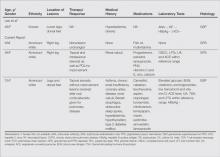Granulomatous Changes Associated With Pigmented Purpuric Dermatosis
Granulomatous pigmented purpuric dermatosis (GPPD) is a rare entity with few cases reported in the literature. We report 3 cases of pigmented purpuric dermatosis (PPD) with granulomatous features in a 9-year-old boy, a 49-year-old woman, and a 75-year-old woman. We also review the literature on PPDs with granulomatous features, including histopathologic features and disease associations. Most of the cases we reviewed described granulomas superimposed on classic changes of PPD. We also identify a new variant of GPPD in 2 of our patients who presented with granulomatous infiltrates in the mid to deep dermis. Granulomatous PPD does not appear to have a consistent association with underlying disease; notably, hyperlipidemia was seen in 7 cases we reviewed.
Practice Points
- Consider a punch biopsy when sampling suspected inflammatory dermatoses, such as pigmented purpuric dermatosis, to allow deeper sampling.
- Provide all clinical details to the dermatopathologist to assist with clinicopathologic correlation and diagnostic accuracy.
Comment
Pigmented purpuric dermatoses comprise a spectrum of clinical and pathologic conditions.1,2 Granulomatous PPD is a much less common variant, characterized by a granulomatous infiltrate admixed with PPD. We report 3 additional cases and review the literature on this rare and interesting variant of PPD.
We noted several unifying clinicopathologic features among our patients and those previously reported in the literature (Table).3-7 Including our cases, our review yielded 13 GPPD patients ranging in age from 9 to 75 years, with a mean age of 49.1 years. Two of our patients—patients 1 and 3—were the youngest and oldest patients, respectively, among the cases we reviewed. The majority of the cases we reviewed included patients of East Asian descent (6 Taiwanese; 2 Japanese; 1 Korean) as well as 4 white patients. No distinctive gender predilection was apparent, as our review included 8 females and 5 males.








